WORLD TRAVEL NEWS ARTICLE

BRAZIL, SOUTH AMERICA


The 2016 Summer Olympics, officially known as the Games of the XXXI Olympiad will be hosted by the city of Rio de Janeiro, Brazil. They are scheduled to be held from August 5 to 21, 2016, making these the second Summer Olympics to be held during the host city's winter (the first was the Sydney 2000 Olympics). It will be the first time a South American city hosts the event.


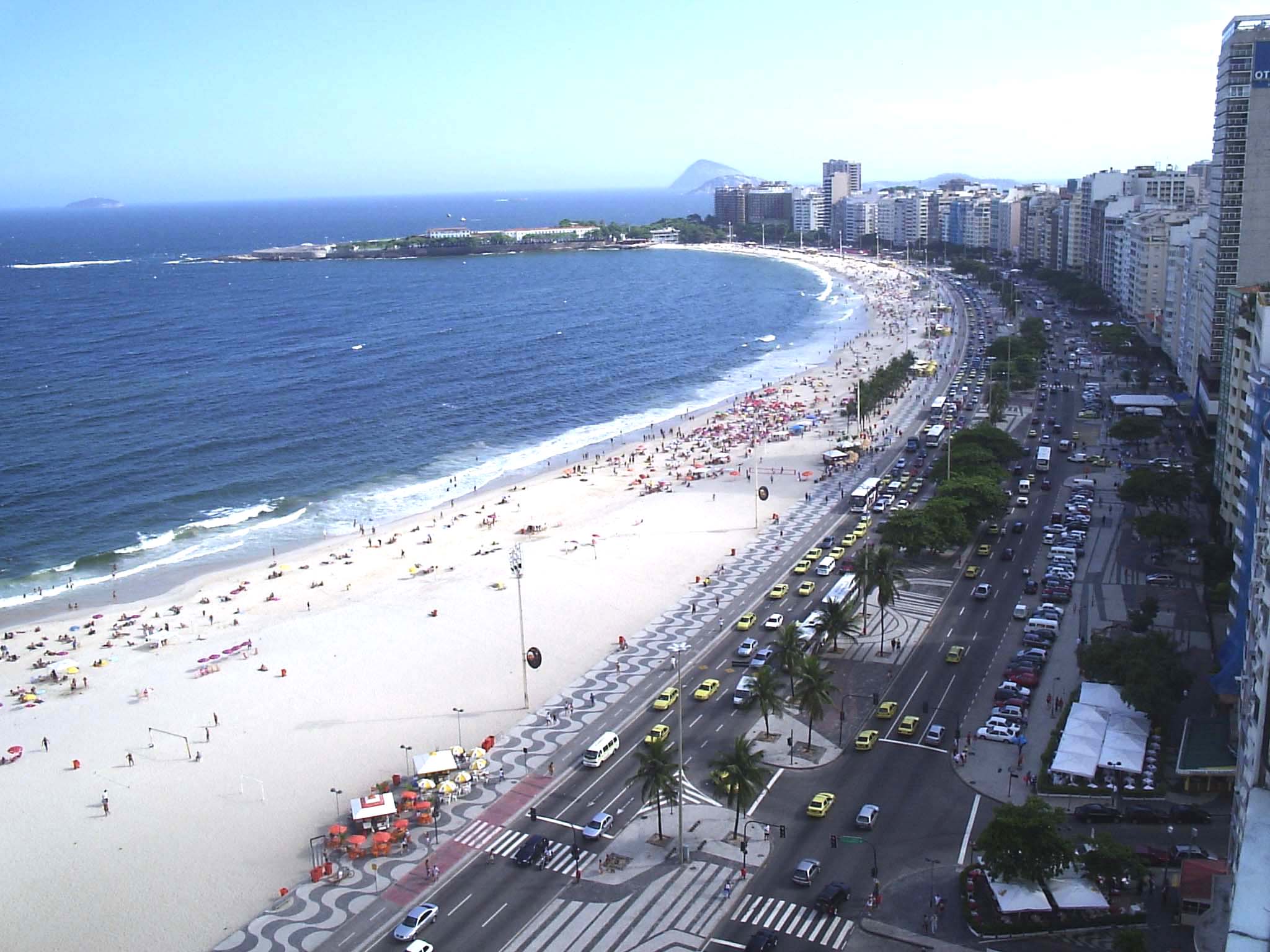
A cable car from the southern zone will take you up Sugar Loaf – Pao de Acucar – where you will be rewarded with food and refreshments at the top so that you can savour the view at your leisure.
It is in the central zone where you will do most exploring and where you will find a veritable feast for the eyes. Wooden sculptures, Portuguese mosaics and tiles, stone arches and columns, ornate gold leaf church interiors and marble proliferate. There are several museums dedicated to art, natural history and history, and there is a national library. The enormous cathedral, boasts some incomparable stained glass. The Municipal Theatre shouldn’t be missed – it was built along the lines of the Paris Opera House and has a rather grand restaurant.
Brazil means Samba, Bossa Nova and Lambada, and if you head for Rio’s Main Square – Praca Floriano – you can enjoy live music in the outdoor cafés. Rio has a huge venue where all the samba students practise before Carnival – the impressive Sambadromo.
Go to Santa Teresa barrio for cobblestone streets and Sound of Music type flower-bedecked chalets clinging on to the hillside. This is a very atmospheric place to be and is where the “arty set” hang out.
North of Rio in the mining region of Minas Gerais province, a must-see is the immaculately preserved colonial city of Ouro Preto. This entire city has been awarded World Heritage Site status by UNESCO and is totally unspoiled. Nearby Mariana is also worthy of a visit to admire the churches built with gold baron money.
Salvador
Salvador was discovered in 1501 by Amerigo Vespucci and was the first capital before Rio took on that honour in 1763. It became infamous during the colonial era for being the centre for African slave trading that brought in labour to work on the sugar cane plantations. More black and mulatto people live here than anywhere else in Brazil. Despite the slave trade or because of it perhaps (they were very religious) the city is littered with beautiful old churches, monasteries and convents. On the square where the cathedral is sited – Terreiro de Jesus – three other churches stand.
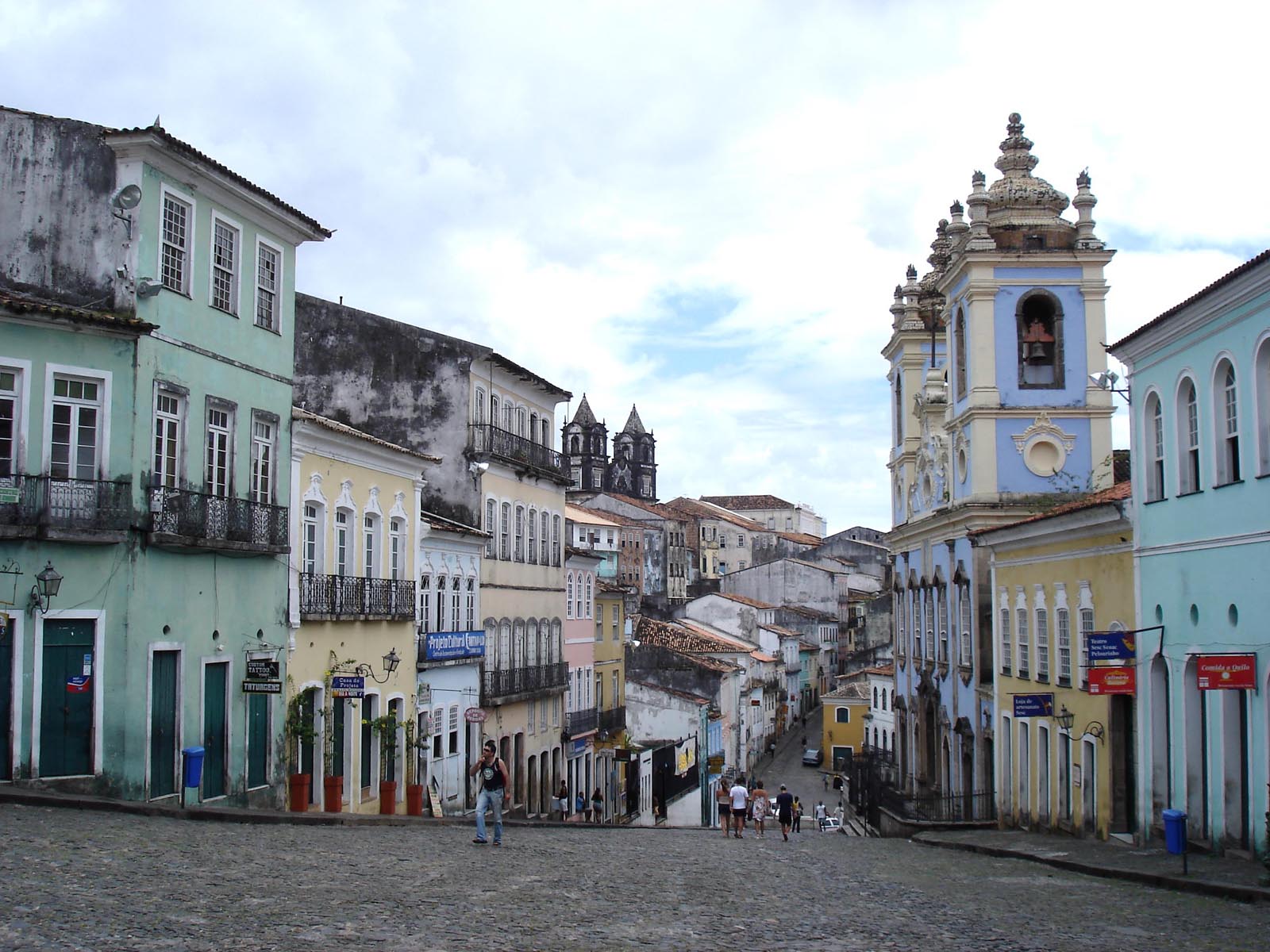
Salvador is where you will see Copoeira, a martial art form of dance, brought here originally by Angolan slaves. The Bahia cuisine here is different, also due to the African influence, in that there is considerable use of coconut and seafood in a mix of Caribbean-style sweet and spicy dishes.
Recife
Recife (“reef”) occupies three interconnected small islands and its bridges and waterways are very reminiscent of Venice although in fact it was the Dutch who initially settled here. Two rivers meet here, and the busy life of the waterside is very picturesque. There is architecture of considerable beauty in this city of winding streets and one-way systems, as well as modern high rise blocks. Visit the old town from Republican Square and see the Governors Palace and the Theatre. There is an elegant cathedral and a market.


Belem's Fish Market
Tourism has increased spectacularly in this region and cruise ships make regular visits encouraging the local people to abandon their natural shyness and mix with the tourists, albeit to interest them in purchasing their handicrafts. Belem (Bethlehem) is known perhaps ironically more for its “lusty” carnival – Carnabelem – than for any link to Christ’s birthplace. You will be spoiled for choice in your visit to art museums and churches and the old cathedral here is beautifully preserved. You will smile to see a Big Ben replica! The daily market is amazing, not only selling fruit, vegetables and fish, but also magic potions. You are as likely to see evidence of jungle superstition here as you are of people wearing crucifixes, although in theory this is a catholic country. People appear to keep their options open and placate the spirits along with saying their prayers. There are restaurants in the market area where you can eat the national dish, feijoada, – black beans, pork, beef or sausages in a flour, egg and onion paste fried in oil, and served with rice.
If you are planning a river cruise from Belem going to Manaus it is essential that you start your anti-malarial course three weeks ahead of your visit, consult your medical practice for up to date advice and recommendations as soon as you start to plan your visit, and be well prepared and with all your vaccinations and medication in place.
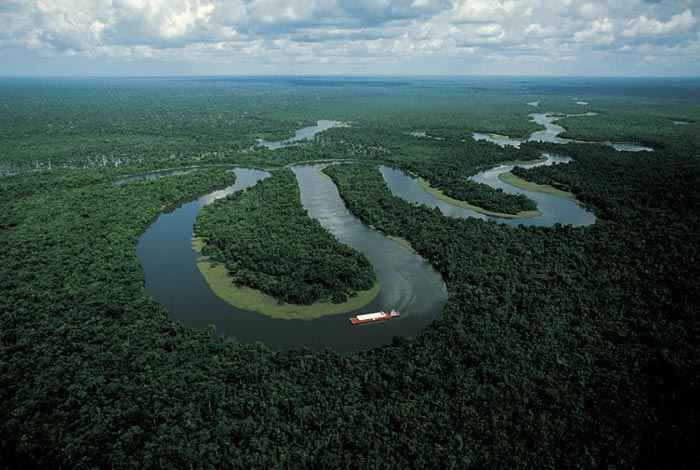
Amazon River near Manaus
Manaus
Jungle capital extraordinary, Manaus is today the hub of a fast growing region. The city’s original olde-worlde mansions and monuments now hide between modern high rise architecture. The miracle from colonial times is the Teatro Amazonas Opera House which was built in 1896 and after two intensive renovation projects, retains its belle époque splendour. It is a symbol of the region’s past “golden age” of the rubber boom, and it ranks as one of the world’s most elegant theatres.

Teatro Amazonas Opera House
The National Institute of Amazonian Research occupies a huge area of botanical gardens with a representative selection of Delta flora and fauna. Examples of Amazonian birds, monkeys and sloths are kept here, along with tropical fish, caimans and turtles.
There is a good Science Museum, with displays of stuffed Amazonian animals and insects. A giant pirarucu occupies an aquarium here; this is the largest scaly fish in Brazil, with an elongated and bulky body that measures some two metres (six feet) long, and it weighs up to 90 kilograms (200 pounds). The museum also houses Indian artefacts, costumes and weapons that belonged to the region’s principal tribes.
São Sebastião Square in the historic part of Manaus should be visited to appreciate the architecture of the buildings. A little further afield, is the special Rubber Scenario and Museum which takes you back to the early rubber collecting days. There is a floating port, a remarkable installation, which was designed by a Scottish engineer to cope with the annual rise and fall of the river.
River cruises and flight seeing excursions are on offer from here, taking you deep into the jungle where you will see local wooden houses, palm trees, monkeys and birds among the dense vegetation. The two rivers that meet to form the Amazon are different colours due to taking on the colour of the soil through which each flows. The extraordinary thing is that both rivers flow alongside each other, refusing to mingle and lose their separate identities, for several miles. Best seen from the air, this is an amazing phenomenon, known as the meeting of the waters.
Sao Paulo
Sao Paulo is the largest city in Brazil, with its adjacent port, Santo. Many Japanese live here, and in fact the Japanese first came here in order to grow peppers. There is a wonderful mix of nations throughout Brazil, perhaps the greatest variety anywhere in the world.
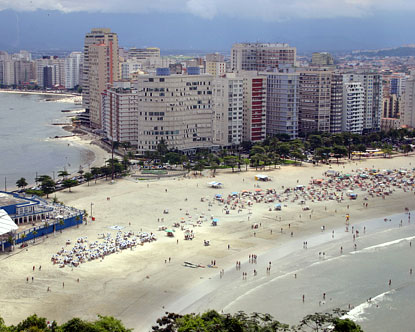
Sao Paulo beaches
Eleven million people live in this industrial city where cars are manufactured along with high tech products and this city is the seat of the export trade. You can get about on the underground metro or by taxi. Throughout Brazil taxis in general are inexpensive, but if you plan to take any long journey you should negotiate your fare in advance.
Sushi bars are to be found everywhere, but so too are restaurants offering other international cuisine of a very high standard. The arts occupy an important place here and both the Theatre and the Museo de Arte de Sao Paulo are well worth visiting. Two lovely green spaces are the Oscar Niemeyer designed Parque do Ibirapuera and Horto Florestal gardens. The nightlife is extremely lively and includes plenty of live music.
Brasilia
Brasilia became Brazil’s capital in 1960, replacing Rio de Janeiro (which in turn replaced Salvador, in 1763). Cooler on its inland plateau, and deliberately planned, this is a spotless, modern, organised city. It boasts a spectacular cathedral with a stained glass domed roof shaped as the Crown of Thorns and many sculptures are to be found strategically placed around the city.
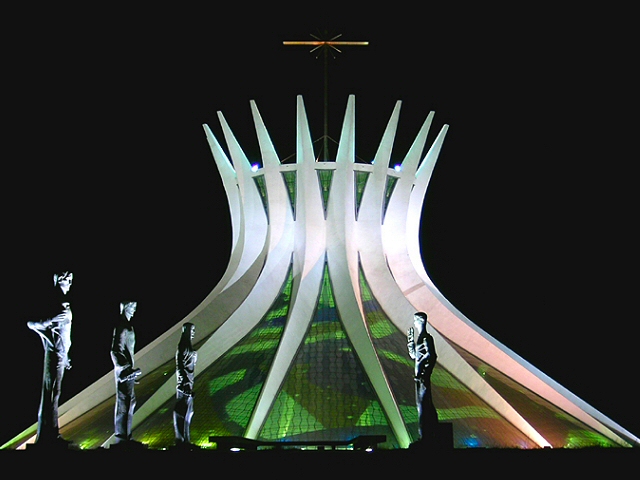
It was the dream of Juscelino Kubitschek who became president in 1955 and he worked with the Brazilian architect Oscar Niemayer (who had studied in Switzerland with Lucio Costa) to see this futuristic magnificent city take shape. Its only failure is that given the motor industry boom at that time, the city was designed for the anticipated motorist, and pedestrians’ needs were ignored.
The twin towers and huge discs of the Congresso Nacional dominate the city. A visit here will entail a lengthy detour from wherever you are, but Brasilia is nonetheless a picture of the new Brazil needed to complete the varied overall view of this land of contrasts that you take home with you.

'FULECO'
The FIFA World Cup Mascot for 2014
If you were wondering which cities are the FIFA World Cup venues - are please take a look at this map.
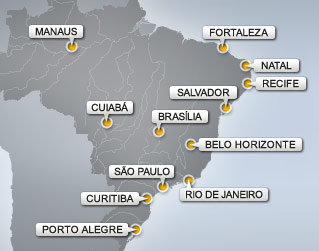

For details about the 2016 Olympic Games and Paralympic Games please visit www.rio2016.org/en .
BRAZIL, SOUTH AMERICA

The 2014 FIFA Football World Cup will be the 20th FIFA World Cup and is scheduled to take place in Brazil from 12 June to 13 July 2014. It will be the second time that Brazil has hosted the competition, the previous being in 1950.

The 2016 Summer Olympics, officially known as the Games of the XXXI Olympiad will be hosted by the city of Rio de Janeiro, Brazil. They are scheduled to be held from August 5 to 21, 2016, making these the second Summer Olympics to be held during the host city's winter (the first was the Sydney 2000 Olympics). It will be the first time a South American city hosts the event.
With all these world class events heading to Brazil over the next 3 years we thought you might like to be reminded about this amazing country - fifth largest in the world.
Brazil occupies the eastern half of the South American continent. In 1494 Portugal and Spain both claimed to have “discovered” the continent and decided to share it between them. Spain permitted self-rule to its western half of the continent with the subsequent result of the formation of independent Spanish speaking countries. The eastern half of the continent was governed continuously from Portugal and remains intact as the vast Portuguese-speaking Brazil.
Brazil shares borders with all but two countries of the former Spanish possessions, Ecuador and Chile, and covers nearly 2,700 miles north to south and slightly more west to east. It is the only Portuguese speaking country on the South American continent.
Brazil shares borders with all but two countries of the former Spanish possessions, Ecuador and Chile, and covers nearly 2,700 miles north to south and slightly more west to east. It is the only Portuguese speaking country on the South American continent.

A reflective Amazon River
Dominated by the Amazon and its many tributaries, much of the country’s vast lowland region has yet to be explored, although with worldwide interest in exploiting the wealth of the Andean jungle on the one hand and in preventing the deforestation and rainforest ecological imbalance on the other, this will not be the case for much longer. Progress versus protection, commerce versus conservation, modernisation versus retention, economic growth versus disturbance to the Amerindian way of life are delicate subjects to tackle and as each interest group considers its own needs to be paramount, the attainment of compromise is an elusive goal.
For the visitor, it is the vast distances between each location you want to visit that poses a logistical problem. New roads, airports, competitive budget airlines, railways and industrialization are making it easier to get around, but it is the sheer size of the country you need to bear in mind. From Rio de Janeiro to the capital Brasilia is 600 miles. It’s another 900 miles from Brasilia to reach Manaus the jungle capital. When you go to Brazil you will want to sample its incredible variety, so plot your itinerary in advance and with care.

Rio de Janeiro
Antonio Carlos Jobim International Airport is north of Rio on an island at Galeao.
Currency is the Portuguese Dollar, the Real $, but as the name of the currency changes regularly please visit www.xe.com for current exchange rates.
Rio de Janeiro
Rio’s harbour is probably the world’s finest, and its wonderful beaches of Copacabana and Ipanema, Sugar Loaf Mountain and Corcorado (the Hunchback) topped with the magnificent statue of Christ the Redeemer overlooking the Bay of Guanabara, need no introduction. The enormous shanty towns, the javelas, surrounding the city, are also well known. Despite the glitter of Rio, wealth sits alongside abject poverty and with Brazil still holding the record as the country with the highest national debt, the gap between rich and poor is only likely to widen in the future. It is quite a contradiction because the natural resources and wealth of Brazil are enormous, what it lacks is cash wealth and the booming economy tends to make the gap wider between the already wealthy and the millions upon millions of incredibly poor. Yet this country is self sufficient, it manufactures for its own needs as well as for its huge export market. There is little it needs to import.
Currency is the Portuguese Dollar, the Real $, but as the name of the currency changes regularly please visit www.xe.com for current exchange rates.
Rio de Janeiro
Rio’s harbour is probably the world’s finest, and its wonderful beaches of Copacabana and Ipanema, Sugar Loaf Mountain and Corcorado (the Hunchback) topped with the magnificent statue of Christ the Redeemer overlooking the Bay of Guanabara, need no introduction. The enormous shanty towns, the javelas, surrounding the city, are also well known. Despite the glitter of Rio, wealth sits alongside abject poverty and with Brazil still holding the record as the country with the highest national debt, the gap between rich and poor is only likely to widen in the future. It is quite a contradiction because the natural resources and wealth of Brazil are enormous, what it lacks is cash wealth and the booming economy tends to make the gap wider between the already wealthy and the millions upon millions of incredibly poor. Yet this country is self sufficient, it manufactures for its own needs as well as for its huge export market. There is little it needs to import.

Rio's famous Copacabana Beach
A cable car from the southern zone will take you up Sugar Loaf – Pao de Acucar – where you will be rewarded with food and refreshments at the top so that you can savour the view at your leisure.
It is in the central zone where you will do most exploring and where you will find a veritable feast for the eyes. Wooden sculptures, Portuguese mosaics and tiles, stone arches and columns, ornate gold leaf church interiors and marble proliferate. There are several museums dedicated to art, natural history and history, and there is a national library. The enormous cathedral, boasts some incomparable stained glass. The Municipal Theatre shouldn’t be missed – it was built along the lines of the Paris Opera House and has a rather grand restaurant.
Brazil means Samba, Bossa Nova and Lambada, and if you head for Rio’s Main Square – Praca Floriano – you can enjoy live music in the outdoor cafés. Rio has a huge venue where all the samba students practise before Carnival – the impressive Sambadromo.
Go to Santa Teresa barrio for cobblestone streets and Sound of Music type flower-bedecked chalets clinging on to the hillside. This is a very atmospheric place to be and is where the “arty set” hang out.
North of Rio in the mining region of Minas Gerais province, a must-see is the immaculately preserved colonial city of Ouro Preto. This entire city has been awarded World Heritage Site status by UNESCO and is totally unspoiled. Nearby Mariana is also worthy of a visit to admire the churches built with gold baron money.
Salvador
Salvador was discovered in 1501 by Amerigo Vespucci and was the first capital before Rio took on that honour in 1763. It became infamous during the colonial era for being the centre for African slave trading that brought in labour to work on the sugar cane plantations. More black and mulatto people live here than anywhere else in Brazil. Despite the slave trade or because of it perhaps (they were very religious) the city is littered with beautiful old churches, monasteries and convents. On the square where the cathedral is sited – Terreiro de Jesus – three other churches stand.

Salvador
Salvador is where you will see Copoeira, a martial art form of dance, brought here originally by Angolan slaves. The Bahia cuisine here is different, also due to the African influence, in that there is considerable use of coconut and seafood in a mix of Caribbean-style sweet and spicy dishes.
Recife
Recife (“reef”) occupies three interconnected small islands and its bridges and waterways are very reminiscent of Venice although in fact it was the Dutch who initially settled here. Two rivers meet here, and the busy life of the waterside is very picturesque. There is architecture of considerable beauty in this city of winding streets and one-way systems, as well as modern high rise blocks. Visit the old town from Republican Square and see the Governors Palace and the Theatre. There is an elegant cathedral and a market.

Recife
Olinda is a neighbouring city whose suburbs have merged with Recife’s so that the two cities have almost become one, has lovely gardens and parks although it is mainly a modern residential zone.
Belem
Belem on the Amazonian Delta marks what the Brazilians term the “gateway” to the interior. The Amazon River Basin is the largest area in the country, the “inferno verde” (green hell – a reference to its heat and humidity), takes up almost half of Brazil in year round temperatures of 27C/80F and receives a lot of rain. Mercury contamination from the 1970s gold rush has created a problem in the Amazon basin still to be resolved.
Belem on the Amazonian Delta marks what the Brazilians term the “gateway” to the interior. The Amazon River Basin is the largest area in the country, the “inferno verde” (green hell – a reference to its heat and humidity), takes up almost half of Brazil in year round temperatures of 27C/80F and receives a lot of rain. Mercury contamination from the 1970s gold rush has created a problem in the Amazon basin still to be resolved.

Belem's Fish Market
Tourism has increased spectacularly in this region and cruise ships make regular visits encouraging the local people to abandon their natural shyness and mix with the tourists, albeit to interest them in purchasing their handicrafts. Belem (Bethlehem) is known perhaps ironically more for its “lusty” carnival – Carnabelem – than for any link to Christ’s birthplace. You will be spoiled for choice in your visit to art museums and churches and the old cathedral here is beautifully preserved. You will smile to see a Big Ben replica! The daily market is amazing, not only selling fruit, vegetables and fish, but also magic potions. You are as likely to see evidence of jungle superstition here as you are of people wearing crucifixes, although in theory this is a catholic country. People appear to keep their options open and placate the spirits along with saying their prayers. There are restaurants in the market area where you can eat the national dish, feijoada, – black beans, pork, beef or sausages in a flour, egg and onion paste fried in oil, and served with rice.
If you are planning a river cruise from Belem going to Manaus it is essential that you start your anti-malarial course three weeks ahead of your visit, consult your medical practice for up to date advice and recommendations as soon as you start to plan your visit, and be well prepared and with all your vaccinations and medication in place.

Amazon River near Manaus
Manaus
Jungle capital extraordinary, Manaus is today the hub of a fast growing region. The city’s original olde-worlde mansions and monuments now hide between modern high rise architecture. The miracle from colonial times is the Teatro Amazonas Opera House which was built in 1896 and after two intensive renovation projects, retains its belle époque splendour. It is a symbol of the region’s past “golden age” of the rubber boom, and it ranks as one of the world’s most elegant theatres.

Teatro Amazonas Opera House
The National Institute of Amazonian Research occupies a huge area of botanical gardens with a representative selection of Delta flora and fauna. Examples of Amazonian birds, monkeys and sloths are kept here, along with tropical fish, caimans and turtles.
There is a good Science Museum, with displays of stuffed Amazonian animals and insects. A giant pirarucu occupies an aquarium here; this is the largest scaly fish in Brazil, with an elongated and bulky body that measures some two metres (six feet) long, and it weighs up to 90 kilograms (200 pounds). The museum also houses Indian artefacts, costumes and weapons that belonged to the region’s principal tribes.
São Sebastião Square in the historic part of Manaus should be visited to appreciate the architecture of the buildings. A little further afield, is the special Rubber Scenario and Museum which takes you back to the early rubber collecting days. There is a floating port, a remarkable installation, which was designed by a Scottish engineer to cope with the annual rise and fall of the river.
River cruises and flight seeing excursions are on offer from here, taking you deep into the jungle where you will see local wooden houses, palm trees, monkeys and birds among the dense vegetation. The two rivers that meet to form the Amazon are different colours due to taking on the colour of the soil through which each flows. The extraordinary thing is that both rivers flow alongside each other, refusing to mingle and lose their separate identities, for several miles. Best seen from the air, this is an amazing phenomenon, known as the meeting of the waters.
Sao Paulo
Sao Paulo is the largest city in Brazil, with its adjacent port, Santo. Many Japanese live here, and in fact the Japanese first came here in order to grow peppers. There is a wonderful mix of nations throughout Brazil, perhaps the greatest variety anywhere in the world.

Sao Paulo beaches
Eleven million people live in this industrial city where cars are manufactured along with high tech products and this city is the seat of the export trade. You can get about on the underground metro or by taxi. Throughout Brazil taxis in general are inexpensive, but if you plan to take any long journey you should negotiate your fare in advance.
Sushi bars are to be found everywhere, but so too are restaurants offering other international cuisine of a very high standard. The arts occupy an important place here and both the Theatre and the Museo de Arte de Sao Paulo are well worth visiting. Two lovely green spaces are the Oscar Niemeyer designed Parque do Ibirapuera and Horto Florestal gardens. The nightlife is extremely lively and includes plenty of live music.
Brasilia
Brasilia became Brazil’s capital in 1960, replacing Rio de Janeiro (which in turn replaced Salvador, in 1763). Cooler on its inland plateau, and deliberately planned, this is a spotless, modern, organised city. It boasts a spectacular cathedral with a stained glass domed roof shaped as the Crown of Thorns and many sculptures are to be found strategically placed around the city.

Brasilia
It was the dream of Juscelino Kubitschek who became president in 1955 and he worked with the Brazilian architect Oscar Niemayer (who had studied in Switzerland with Lucio Costa) to see this futuristic magnificent city take shape. Its only failure is that given the motor industry boom at that time, the city was designed for the anticipated motorist, and pedestrians’ needs were ignored.
The twin towers and huge discs of the Congresso Nacional dominate the city. A visit here will entail a lengthy detour from wherever you are, but Brasilia is nonetheless a picture of the new Brazil needed to complete the varied overall view of this land of contrasts that you take home with you.

'FULECO'
The FIFA World Cup Mascot for 2014
If you were wondering which cities are the FIFA World Cup venues - are please take a look at this map.


For details about the 2016 Olympic Games and Paralympic Games please visit www.rio2016.org/en .
You may also like to read
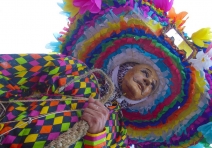
MEXICO - Central America
Tour-smart takes you to Mexico for holidays on the two oceans of Central America.
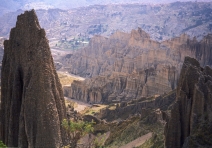
BOLIVIA - South America
A fascinating country, Tour-smart gives you an insight to landlocked Bolivia which boasts the world’s highest capital city - La Paz.

Comments